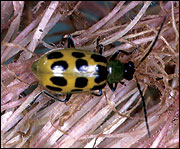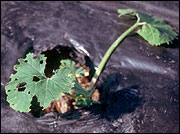Cucumber beetles
Spotted cucumber beetle (Diabrotica undecimpuntata howardii (Barber)) and striped cucumber beetle (Acalymma vittata (Fabricius)) are serious insect pests of field-grown cucurbits in the central Midwest. Cucumber beetles are 1/4-inch-long beetles with either 12 spots (spotted cucumber beetle) or three black stripes (striped cucumber beetle) on their abdomens (Figure 19). Both species can overwinter in Missouri and become active in April when daytime temperatures exceed 55 degrees Fahrenheit.
Adult beetles begin feeding on cotyledons (seed leaves) of transplants and continue to feed on the emerging leaves, stems, flowers and eventually the fruit surface (watermelon). Both species can transmit bacterial wilt (Erwinia tracheiphilia) to cantaloupes and muskmelons (Figure 19). Watermelons are not susceptible to bacterial wilt.
Within two weeks after transplanting, begin scouting for cucumber beetles in the high tunnel. Use yellow sticky traps to detect cucumber beetles.
Cucumber beetles are very mobile. Insect exclusion screens can be used to control cucumber beetles entry into the high tunnel. Systemic insecticides applied as a post transplant drench will provide about 35 days of control, which is long enough to reduce bacterial wilt infection. Further control through the growing season can be accomplished by applying foliar insecticides. Avoid using insecticides that may be toxic to pollinating insects. There are no effective biological control techniques for cucumber beetle.

 Photo credit: Lee Jenkins Slide Collection, MU
Photo credit: Lee Jenkins Slide Collection, MU